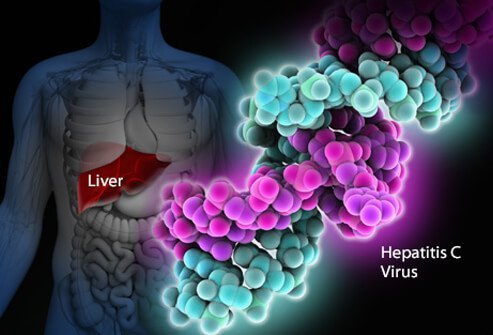 Kaj je HCV, kako se prenaša, ali obstajajo simptomi in ali je ozdravljiv?
Kaj je HCV, kako se prenaša, ali obstajajo simptomi in ali je ozdravljiv?Večina ljudi, ki zboli za hepatitisom C (hep C), nima simptomov. Vendar pa lahko tisti, ki imajo simptome, doživijo:
Okužba z virusom hepatitisa C je okužba jeter, ki jo povzroča virus hepatitisa C (imenovan tudi HCV ali hep C). Človeški imunski sistem težko odstrani hepatitis C iz telesa, okužba s hepatitisom C pa običajno postane kronična. V desetletjih kronična okužba s hepatitisom C poškoduje jetra in lahko povzroči odpoved jeter. V ZDA je CDC ocenil, da se je v letu 2016 pojavilo približno 41.200 novih primerov hepatitisa C. Ko virus prvič vstopi v telo, običajno ni simptomov, zato je ta številka ocena. Približno 75–85 % na novo okuženih se kronično okuži. Ocenjuje se, da je v ZDA več kot 2 milijona ljudi kronično okuženih s hepatitisom C. Okužba se najpogosteje odkrije med ljudmi, starimi od 40 do 60 let, kar odraža visoke stopnje okužb v 70. in 80. letih prejšnjega stoletja. V ZDA vsako leto umre od 8.000 do 10.000 smrti zaradi okužbe s hepatitisom C. Okužba s HCV je glavni vzrok za presaditev jeter v ZDA in je dejavnik tveganja za raka na jetrih. Leta 2016 je 18.153 smrtnih listov navedlo HCV kot vzrok smrti; to naj bi bilo podcenjeno.
Približno 10–20 % tistih, ki razvijejo kronični HCV, bo v 20–30 letih razvilo cirozo. Napredovanje v cirozo se lahko pospeši pri starosti nad 50 let, moškem spolu, uživanju alkohola, nealkoholni maščobni bolezni jeter (NASH), sočasni okužbi s hepatitisom B ali HIV in zdravilih za zaviranje imunskega sistema. Okužba s HCV je glavni vzrok za presaditev jeter zaradi odpovedi jeter v ZDA.
Tisti, ki imajo cirozo zaradi HCV, imajo tudi letno tveganje za raka na jetrih (hepatom ali hepatocelularni karcinom) približno 1-5%.
Hepatitis pomeni vnetje jeter. Hepatitis C je eden od več virusov, ki lahko povzročijo virusni hepatitis. Ni povezan z drugimi pogostimi virusi hepatitisa (na primer hepatitisom A ali hepatitisom B). Hepatitis C je član Flaviviridae družina virusov. Drugi člani te družine virusov vključujejo tiste, ki povzročajo rumeno mrzlico in mrzlico denga.
Obstaja vsaj šest različnih genotipov (sevov) virusa, ki imajo različne genetske profile (genotipi 1 do 6). V ZDA je genotip 1 najpogostejši sev hepatitisa C. Tudi znotraj enega samega genotipa lahko obstajajo nekatere razlike (na primer genotip 1a in 1b). Genotipizacija se uporablja za usmerjanje zdravljenja, ker se nekateri virusni genotipi bolje odzivajo na nekatere terapije kot na druge.
Tako kot virus človeške imunske pomanjkljivosti (HIV) se hepatitis C zelo hitro razmnožuje in doseže zelo visoke ravni v telesu. Geni, ki tvorijo površinske beljakovine virusa, prav tako hitro mutirajo (spreminjajo) in na tisoče genetskih variacij virusa ("kvazi-vrste") se dnevno proizvaja. Telo ne more slediti izdelavi protiteles proti HCV proti vsem kvazi-vrstam, ki krožijo naenkrat. Učinkovitega cepiva še ni bilo mogoče razviti, ker mora cepivo ščititi pred vsemi genotipi.
Okužba s hepatitisom C v jetrih sproži imunski sistem, kar vodi v vnetje. Približno 20–30 % akutno okuženih bo imelo tipične simptome hepatitisa, kot so bolečine v trebuhu, zlatenica, temen urin ali blato v barvi gline. Vendar pa kronični hepatitis C običajno ne povzroča nobenih simptomov do zelo pozne faze bolezni, hepatitis C pa so bolniki imenovali "speči zmaj". V več letih ali desetletjih lahko kronično vnetje povzroči smrt jetrnih celic in brazgotinjenje ("fibroza"). Obsežne brazgotine v jetrih se imenujejo ciroza. To postopoma poslabša vitalne funkcije jeter. Cirotična jetra so bolj nagnjena k raku jeter. Pitje alkohola pospeši poškodbe jeter s hepatitisom C. Sočasna okužba s HIV, pa tudi akutna okužba s hepatitisom A ali B, bosta prav tako pospešila napredovanje v cirozo.
Približno 70% -80% ljudi nima nobenih simptomov, ko se prvič okužijo s HCV. Preostalih 20 %–30 % jih je morda
Zgodnji simptomi hepatitisa C lahko vključujejo temen urin, rumene oči ali blato v barvi gline, čeprav je to nenavadno. Sčasoma lahko ljudje s kronično okužbo s HCV razvijejo znake vnetja jeter, ki nakazujejo, da je okužba lahko prisotna. Okuženi posamezniki se lahko hitro utrudijo ali se pritožujejo zaradi nespecifičnih simptomov. Kasnejši simptomi in znaki ciroze so pogosto odsotni, dokler vnetje ni precej napredovalo. Ko ciroza napreduje, se simptomi in znaki povečujejo in lahko vključujejo:
Ker se hepatitis C prenaša s krvjo, ni posebnega obdobja nalezljivosti. Ljudje, ki razvijejo kronični hepatitis C, nosijo virus v krvi in so zato nalezljivi za druge vse življenje, razen če so ozdravljeni hepatitisa C.
Težko je z gotovostjo reči, kakšna je inkubacijska doba za hepatitis C, saj večina ljudi, ki so okuženi s hepatitisom C, nima simptomov zgodaj v poteku okužbe. Tisti, pri katerih se simptomi pojavijo zgodaj po okužbi (v povprečju od 2 do 12 tednov, lahko pa tudi dlje), imajo blage gastrointestinalne simptome, ki morda ne zahtevajo obiska zdravnika.
Večina znakov in simptomov okužbe s hepatitisom C se nanaša na jetra. Manj pogosto lahko okužba s hepatitisom C prizadene druge organe kot jetra.
Okužba s hepatitisom C lahko povzroči, da telo proizvaja nenormalna protitelesa, imenovana krioglobulini. Krioglobulini povzročajo vnetje arterij (vaskulitis). To lahko poškoduje kožo, sklepe in ledvice. Bolniki s krioglobulinemijo (krioglobulini v krvi) imajo lahko
Poleg tega se pri okuženih posameznikih s krioglobulinemijo lahko razvije Raynaudov fenomen, pri katerem se prsti na rokah in nogah obarvajo (belo, nato vijolično, nato rdeče) in postanejo boleči pri nizkih temperaturah.
Delovna skupina ameriške preventivne zdravstvene službe priporoča, da se vsi odrasli, rojeni med letoma 1945 in 1965, enkrat rutinsko testirajo na hepatitis C, ne glede na to, ali so prisotni dejavniki tveganja za hepatitis C. Enkratno testiranje je priporočljivo tudi za:
Ljudje, ki so bili morda izpostavljeni hepatitisu C v zadnjih 6 mesecih, je treba testirati na obremenitev virusne RNA namesto protiteles proti HCV, ker protitelesa morda ne bodo prisotna do 12 tednov ali dlje po okužbi, čeprav je HCV RNA mogoče zaznati v krvi že 2-3 tedne po okužbi.
Na splošno je lahko letni presejalni pregled primeren za ljudi s stalnimi dejavniki tveganja, kot so ponavljajoče se spolno prenosljive bolezni (SPB) ali številni spolni partnerji, nenehno uživanje drog IV ali dolgotrajni spolni partnerji ljudi s hepatitisom C. Ali je treba testirati ali ne. te osebe se določi na podlagi odločitve od primera do primera.
Tveganje za prenos HCV z matere na dojenčka je 4-7 % z vsako nosečnostjo. Trenutno ni priporočil CDC za rutinsko presejanje hepatitisa C med nosečnostjo in trenutno ni priporočenega zdravila za preprečevanje prenosa z matere na otroka (profilaksa). Vendar pa CDC spremlja ugotovitve raziskav in lahko v prihodnosti da priporočila, ko se pojavijo dokazi.
Čeprav so podatki še vedno omejeni, je nedavna študija o več kot 1000 primerih v Združenem kraljestvu pokazala, da je bilo 11 % dojenčkov okuženih ob rojstvu in da je pri teh dojenčkih verjetno prišlo do ciroze v zgodnjih 30-ih letih. Primer presejanja za HCV med nosečnostjo vključuje možnost varnega zdravljenja mater med nosečnostjo z neposredno delujočimi protivirusnimi sredstvi (DAA) za zdravljenje matere, preden se razvije ciroza, preprečevanje prenosa pri dojenčkih in preprečevanje prenosa na druge. Otrokom, rojenim materam, okuženim s HCV, se lahko ponudi tudi zdravljenje v zgodnji starosti, da se prepreči ciroza in prenos na druge. Za dosego teh ciljev bo pomembna koordinacija oskrbe med več specialisti.
Otroci mater, okuženih s HCV, se lahko pregledajo za hepatitis C že pri starosti 1-2 mesecev z uporabo virusne obremenitve hepatitisa C ali PCR (glejte Krvne preiskave za hepatitis C). Protitelesa proti hepatitisu C, ki se prenašajo z matere na otroka, bodo prisotna do 18 mesecev, zato je treba otroke testirati na protitelesa HCV ne prej kot to.
Hepatitis C zdravi bodisi gastroenterolog, hepatolog (gastroenterolog z dodatnim usposabljanjem za bolezni jeter) ali specialist za nalezljive bolezni. Zdravstvena ekipa lahko vključuje več kot enega specialista, odvisno od obsega okvare jeter. Kirurgi, ki so specializirani za kirurgijo jeter, vključno s presaditvijo jeter, so del medicinske ekipe in morajo obiskati bolnike z napredovalo boleznijo (odpoved jeter ali ciroza) zgodaj, preden bolnik potrebuje presaditev jeter. Morda bodo lahko ugotovili težave, ki jih je treba obravnavati, preden se lahko razmisli o operaciji. Druge osebe, ki so lahko v pomoč pri obravnavi bolnikov, so dietetiki, ki se posvetujejo o prehranskih vprašanjih, in farmacevti, ki pomagajo pri zdravljenju zdravil.
Obstaja več krvnih preiskav za diagnozo okužbe s hepatitisom C. V krvi je mogoče testirati protitelesa proti hepatitisu C (protitelesa proti HCV). V povprečju traja približno 8-12 tednov in do 6 mesecev, da se protitelesa razvijejo po začetni okužbi s hepatitisom C, zato lahko presejanje na protitelesa izpusti nekaj na novo okuženih posameznikov. Prisotnost protiteles ni absolutni znak aktivnega virusa hepatitisa C, ki se razmnožuje, vendar če je test protiteles pozitiven (prisotna protitelesa), je statistična verjetnost aktivne okužbe večja od 99%.
Na voljo je več testov za merjenje količine virusa hepatitisa C v krvi osebe (virusna obremenitev). RNA virusa hepatitisa C je mogoče identificirati z vrsto testa, imenovanega polimerazna verižna reakcija (PCR), ki odkrije krožeči virus v krvi že 2-3 tedne po okužbi, zato ga je mogoče uporabiti za odkrivanje suma akutne okužbe s hepatitisom C. zgodnja okužba. Uporablja se tudi za ugotavljanje, ali je aktivni hepatitis prisoten pri nekom, ki ima protitelesa proti hepatitisu C, in za spremljanje virusne obremenitve med zdravljenjem.
Za identifikacijo genotipov HCV se izvajajo tudi krvni testi. Genotipi se različno odzivajo na različno zdravljenje, zato so te informacije pomembne pri izbiri najprimernejšega režima zdravljenja.
Tudi ocena jetrne fibroze s krvnimi preiskavami je precej zanesljiva pri diagnosticiranju klinično pomembnih brazgotin; ti vključujejo FIB-4, FibroSure, Fibrotest in indeks razmerja med aspartat aminotransferazo in trombociti (APRI).
Naslednji korak je določitev stopnje brazgotinjenja jeter, ki se je pojavila. Biopsija jeter omogoča pregled majhnega vzorca jetrnega tkiva pod mikroskopom, vendar je biopsija jeter invaziven test in ima veliko tveganje za krvavitev. Prav tako lahko zgreši nenormalna področja v zgodnji bolezni.
Neinvazivni testi so v veliki meri nadomestili biopsijo jeter, razen v posebnih situacijah. Otrdelost jeter kaže, da je lahko prisotna napredovala jetrna brazgotina ali ciroza. Prehodno elastografijo lahko uporabimo za merjenje te togosti z ultrazvokom ali slikanjem z magnetno resonanco (MRI).
Pre-treatment evaluation for hepatitis C also should include:
Interferons, for example, Roferon-A and Infergen, and pegylated interferons such as Peg-Intron T , Pegasys, were mainstays of treatment for years. Interferons produced sustained viral response (SVR, or cure) of up to 15%. Later, peglatedll forms produced SVR of 50%-80%. These drugs were injected, had many adverse effects, required frequent monitoring, and were often combined with oral ribavirin, which caused anemia. Treatment durations ranged up to 48 weeks.
Direct-acting anti-viral agents (DAAs) are antiviral drugs that act directly on hepatitis C multiplication.
Hepatitis C treatment is best discussed with a doctor or specialist familiar with current and developing options as this field is changing, and even major guidelines may become outdated quickly.
The latest treatment guidelines by the American Association for the Study of Liver Disease (AASLD) and Infectious Disease Society of America (IDSA) recommends use of DAAs as first-line treatment for hepatitis C infection. The choice of DAA varies by specific virus genotype, and the presence or absence of cirrhosis. In the U.S., specific insurance providers also might influence the choice due to the high cost of DAAs. Although the individual, public health, and cost benefits of treating all patients with hepatitis C is clear, the most difficult barrier to treating all people with HCV is the very high cost of the drug regimens. Patients are encouraged to discuss options with their health care professional.
Treatment is recommended in all patients with chronic hepatitis C unless they have a short life expectancy that is not related to liver disease. Severe life-threatening liver disease may require liver transplantation. Newer therapies with DAAs have allowed more and more patients to be treated.
The ultimate goals of antiviral therapy are to
A side goal is preventing co-infections with other hepatitis viruses, such as A and B, which can cause more liver disease than HCV alone. These can be prevented by vaccines and treatment.
When people first get hepatitis C, the infection is said to be acute. Most people with acute hepatitis C do not have symptoms so they are not recognized as being infected. However, some have low-grade fever, fatigue or other symptoms that lead to an early diagnosis. Others who become infected and have a known exposure to an infected source, such as a needlestick injury, are monitored closely.
Treatment decisions should be made on a case-by-case basis. Response to treatment is higher in acute hepatitis infection than chronic infection. However, many experts prefer to hold off treatment for 8-12 weeks to see whether the patient naturally eliminates the virus without treatment. Approaches to treatment are evolving. Patients with acute hepatitis C infection should discuss treatment options with a health care professional who is experienced in treating the disease. There is no established treatment regimen at this time.
If the hepatitis C RNA remains undetectable at the end of the treatment and follow-up period, this is called a sustained virologic response (SVR) and is considered a cure. Over 90% of people treated with DAAs are cured. These people have significantly reduced liver inflammation, and liver scarring may even be reversed.
About 5% of people who are treated for HCV infection are not cured by some of the older regimens. These people may still have options for cure with the newer regimens.
Few people with hepatitis C are at risk for problems if they are treated, however there are some factors that affect treatment regimens, such as concurrent HIV medications and kidney dysfunction. Some drugs are not safe for people with cirrhosis. Individuals who are unable to comply with the treatment schedule for psychological reasons or ongoing drug or alcohol abuse may not be good candidates for treatment because the drugs are very costly and require adherence to the pill regimen and regular follow-up visits. There are some important drug interactions with some of the medications that should be considered by the health care professional.
People with past hepatitis B or who have chronic active hepatitis B should not be treated for HCV without treating for HBV as well. As highly effective treatment for HCV has emerged, reports of serious hepatitis B have come to light. Similar to HCV, hepatitis B usually does not clear from the liver after acute infection, even though it is far less likely to cause chronic active hepatitis than hepatitis C infection. It remains dormant in most people, but it can reactivate with changes in the immune system. It is not clear why eliminating the HCV can allow the HBV infection to flare up. Hepatitis B screening is an important part of the hepatitis C evaluation. Those who have laboratory evidence of active or past infection with HBV should be monitored while receiving HCV treatment.
Compared to interferons and ribavirin drugs, the side effects of DAAs are far fewer and more tolerable. These side effects usually do not require discontinuation of therapy and are self-limiting after completion of therapy.
Patients with hepatitis B co-infection should be monitored for symptoms of reactivation of hepatitis, which are the same as the symptoms of acute hepatitis. The treating doctor may perform blood screening for this as well.
Hepatitis C is the leading reason for 40% to 45% of liver transplants in the U.S. Hepatitis C usually recurs after transplantation and infects the new liver. Approximately 25% of these patients with recurrent hepatitis will develop cirrhosis within five years of transplantation. Despite this, the five-year survival rate for patients with hepatitis C is similar to that of patients who are transplanted for other types of liver disease.
Most transplant centers delay therapy until recurrent hepatitis C in the transplanted liver is confirmed. Oral, highly effective, direct-acting antivirals have shown encouraging results in patients who have undergone liver transplantation for hepatitis C infection and have recurrent hepatitis C. The choice of therapy needs to be individualized and is rapidly evolving.
Once patients successfully complete treatment, the viral load after treatment determines if there is an SVR or cure. If cure is achieved (undetectable viral load after treatment), no further additional testing is recommended unless the patient has cirrhosis. Those who are not cured will need continued monitoring for progression of liver disease and its complications.
While cure eliminates worsening of fibrosis by hepatitis C, complications may still affect those with cirrhosis. These individuals still need regular screening for liver cancer as well as monitoring for esophageal varices that may bleed.
Because hepatitis B co-infection may reactivate or worsen even after treatment for HCV, monitoring for hepatitis symptoms may be needed after the end of therapy.
At this time there are no effective home or over-the-counter treatments for hepatitis C.
Over several years or decades, chronic inflammation may cause death of liver cells and cirrhosis (scaring, fibrosis). When the liver becomes cirrhotic, it becomes stiff, and it cannot perform its normal functions of clearing waste products from the blood. As fibrosis worsens, symptoms of liver failure begin to appear. This is called "decompensated cirrhosis " or "end-stage liver disease. " Symptoms of end-stage liver disease include:
The liver and spleen have an important function of clearing bacteria from the blood stream. Cirrhosis affects many areas of immune function, including attraction of white blood cells to bacteria, reduced killing of bacteria, reduced production of proteins involved in immune defenses, and decreased life span of white blood cells involved in immune defenses. This may be referred to as having cirrhosis-associated immune dysfunction syndrome or CAIDS.
Transmission of hepatitis C can be prevented in several ways.
Prevention programs aim at needle sharing among drug addicts. Needle exchange programs and education have reduced transmission of hepatitis C infection. However, IV drug users are a difficult to reach population, and rates of hepatitis C remain high among them.
Among health care workers, safe needle-usage techniques have been developed to reduce accidental needlesticks. Newer needle systems prevent manual recapping of needles after use of syringes, which is a frequent cause of accidental needlesticks
There is no clear way to prevent hepatitis C transmission from mother to fetus at this time.
People with multiple sexual partners should use barrier precautions such as condoms to limit the risk of hepatitis C and other sexually transmitted diseases, including HIV.
If one partner is infected, monogamous couples may want to consider the low risk of transmission of hepatitis C infection when deciding whether to use condoms during sex. Some couples may decide to use them and some may not.
Screening of the blood supply has almost eliminated the risk of transmission of hepatitis C infection through transfusion.
People with hepatitis C infection should not share razors or toothbrushes with others because of the possibility that these items may be contaminated with blood.
People who want to get a body piercing(s) or tattoo(s) are encouraged to do so only at licensed piercing and tattoo shops (facilities), and verify that the body piercing or tattoo shop uses infection-control practices.
It is critical that physicians and clinics follow manufacturers and regulatory agency directions for sterilizing/cleaning instruments and that disposable instruments be discarded properly. There is no need to use special isolation procedures when dealing with hepatitis C infected patients.
In general, among patients with untreated hepatitis C:
Drinking alcohol and acquiring other hepatitis viruses are risk factors for worse liver disease. People with chronic hepatitis C should avoid drinking alcohol and should be screened for antibodies to hepatitis A and B. If they do not have antibodies, they should be vaccinated against these other hepatitis viruses.
People with hepatitis C should be educated about preventing HIV infection. Infection with both HIV and hepatitis C speeds up and worsens liver damage caused by hepatitis C. Hepatitis C also can affect the HIV infection and how it is treated. About 25% of people with HIV infection are co-infected (also infected) with hepatitis C, and up to 90% of IV drug users with HIV are co-infected with hepatitis C. Screening for hepatitis viruses is important in all people infected with HIV, just as screening for HIV is important in people who have hepatitis C.
Liver cancer (hepatocellular carcinoma, or hepatoma) is associated with cirrhosis from chronic hepatitis C. Some experts recommend screening patients with hepatitis C infection and cirrhosis for liver cancer periodically.
As our knowledge of hepatitis C increases, more and more patients are being diagnosed with chronic infection. Current research is very active and includes diagnosis, natural history, treatment, and vaccine development. Thus the field is constantly changing, with new guidelines added frequently.
 Priboljški z nizko vsebnostjo FODMAP
Dieta z nizko vsebnostjo FODMAP se pogosto napačno razlaga kot stroga prehrana z zdravo hrano, ki ne dovoljuje priboljškov in sladkarij. Čeprav je res, da številne slane in sladke sladice vsebujejo ve
Priboljški z nizko vsebnostjo FODMAP
Dieta z nizko vsebnostjo FODMAP se pogosto napačno razlaga kot stroga prehrana z zdravo hrano, ki ne dovoljuje priboljškov in sladkarij. Čeprav je res, da številne slane in sladke sladice vsebujejo ve
 Najpogostejši sprožilec driske (ki ga ignorirate)
Pred nekaj leti sem imela stranko z ulceroznim kolitisom, ki je končno utrdila idejo, da sta lahko naš življenjski slog in natančneje stres edina stvar, ki nam preprečuje, da bi postali zdravi. Evo,
Najpogostejši sprožilec driske (ki ga ignorirate)
Pred nekaj leti sem imela stranko z ulceroznim kolitisom, ki je končno utrdila idejo, da sta lahko naš življenjski slog in natančneje stres edina stvar, ki nam preprečuje, da bi postali zdravi. Evo,
 Je svetlo rdeča kri v blatu resna?
Je svetlo rdeča kri v blatu resna? Zdravnik mora oceniti svetlo rdečo kri v blatu. Prisotnost krvi v blatu mora oceniti zdravnik. V večini primerov svetlo rdeča kri v blatu ni neposredna nevarnos
Je svetlo rdeča kri v blatu resna?
Je svetlo rdeča kri v blatu resna? Zdravnik mora oceniti svetlo rdečo kri v blatu. Prisotnost krvi v blatu mora oceniti zdravnik. V večini primerov svetlo rdeča kri v blatu ni neposredna nevarnos